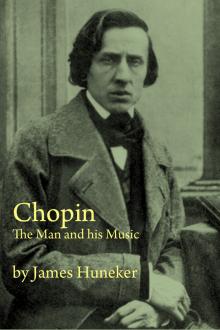Chopin: The Man and His Music, James Huneker [free e books to read online txt] 📗

- Author: James Huneker
- Performer: -
Book online «Chopin: The Man and His Music, James Huneker [free e books to read online txt] 📗». Author James Huneker
Riemann repeats his trick of breaking a group, detaching a note for emphasis; although he is careful to retain the legato bow. One wonders why this study does not figure more frequently on programmes of piano recitals. It is a fine, healthy technical test, it is brilliant, and the coda is very dramatic. Ten bars before the return of the theme there is a stiff digital hedge for the student. A veritable lance of tone is this study, if justly poised.
Riemann has his own ideas of the phrasing of the following one, the fifth and familiar “Black Key” etude. Examine the first bar: [Musical Illustration without caption]
Von Bulow would have grown jealous if he had seen this rather fantastic phrasing. It is a trifle too finical, though it must be confessed looks pretty. I like longer breathed phrasing. The student may profit by this analysis. The piece is indeed, as Kullak says, “full of Polish elegance.” Von Bulow speaks rather disdainfully of it as a Damen-Salon Etude. It is certainly graceful, delicately witty, a trifle naughty, arch and roguish, and it is delightfully invented. Technically, it requires smooth, velvet-tipped fingers and a supple wrist. In the fourth bar, third group, third note of group, Klindworth and Riemann print E flat instead of D flat. Mikuli, Kullak and Von Bulow use the D
flat. Now, which is right? The D flat is preferable. There are already two E flats in the bar. The change is an agreeable one. Joseffy has made a concert variation for this study. The metronome of the original is given at 116 to the quarter.
A dark, doleful nocturne is No. 6, in E flat minor. Niecks praises it in company with the preceding one in E. It is beautiful, if music so sad may be called beautiful, and the melody is full of stifled sorrow.
The study figure is ingenious, but subordinated to the theme. In the E
major section the piece broadens to dramatic vigor. Chopin was not yet the slave of his mood. There must be a psychical programme to this study, some record of a youthful disillusion, but the expression of it is kept well within chaste lines. The Sarmatian composer had not yet unlearned the value of reserve. The Klindworth reading of this troubled poem is the best though Kullak used Chopin’s autographic copy. There is no metronomic sign in this autograph. Tellefsen gives 69 to the quarter; Klindworth, 60; Riemann, 69; Mikuli, the same; Von Bulow and Kullak, 60. Kullak also gives several variante from the text, adding an A flat to the last group in bar II. Riemann and the others make the same addition. The note must have been accidentally omitted from the Chopin autograph. Two bars will illustrate what Riemann can accomplish when he makes up his mind to be explicit, leaving little to the imagination:
[Illustration without caption]
A luscious touch, and a sympathetic soul is needed for this nocturne study.
We emerge into a clearer, more bracing atmosphere in the C major study, No. 7. It is a genuine toccata, with moments of tender twilight, serving a distinct technical purpose—the study of double notes and changing on one key—and is as healthy as the toccata by Robert Schumann. Here is a brave, an undaunted Chopin, a gay cavalier, with the sunshine shimmering about him. There are times when this study seems like light dripping through the trees of a mysterious forest; with the delicato there are Puck-like rustlings, and all the while the pianist without imagination is exercising wrist and ringers in a technical exercise! Were ever Beauty and Duty so mated in double harness? Pegasus pulling a cloud charged with rain over an arid country! For study, playing the entire composition with a wrist stroke is advisable. It will secure clear articulation, staccato and finger-memory. Von Bulow phrases the study in groups of two, Kullak in sixes, Klindworth and Mikuli the same, while Riemann in alternate twos, fours and sixes. One sees his logic rather than hears it. Von Bulow plastically reproduces the flitting, elusive character of the study far better than the others.
It is quite like him to suggest to the panting and ambitious pupil that the performance in F sharp major, with the same fingering as the next study in F, No. 8, would be beneficial. It certainly would. By the same token, the playing of the F minor Sonata, the Appassionata of Beethoven, in the key of F sharp minor, might produce good results.
This was another crotchet of Wagner’s friend and probably was born of the story that Beethoven transposed the Bach fugues in all keys. The same is said of Saint-Saens.
In his notes to the F major study Theodor Kullak expatiates at length upon his favorite idea that Chopin must not be played according to his metronomic markings. The original autograph gives 96 to the half, the Tellefsen edition 88, Klindworth 80, Von Bulow 89, Mikuli 88, and Riemann the same. Kullak takes the slower tempo of Klindworth, believing that the old Herz and Czerny ideals of velocity are vanished, that the shallow dip of the keys in Chopin’s day had much to do with the swiftness and lightness of his playing. The noble, more sonorous tone of a modern piano requires greater breadth of style and less speedy passage work. There can be no doubt as to the wisdom of a broader treatment of this charming display piece. How it makes the piano sound—what a rich, brilliant sweep it secures! It elbows the treble to its last euphonious point, glitters and crests itself, only to fall away as if the sea were melodic and could shatter and tumble into tuneful foam! The emotional content is not marked. The piece is for the fashionable salon or the concert hall. One catches at its close the overtones of bustling plaudits and the clapping of gloved palms.
Ductility, an aristocratic ease, a delicate touch and fluent technique will carry off this study with good effect. Technically it is useful; one must speak of the usefulness of Chopin, even in these imprisoned, iridescent soap bubbles of his. On the fourth line and in the first bar of the Kullak version, there is a chord of the dominant seventh in dispersed position that does not occur in any other edition. Yet it must be Chopin or one of his disciples, for this autograph is in the Royal Library at Berlin. Kullak thinks it ought to be omitted, moreover he slights an E flat, that occurs in all the other editions situated in the fourth group of the twentieth bar from the end.
The F minor study, No. 9, is the first one of those tone studies of Chopin in which the mood is more petulant than tempestuous. The melody is morbid, almost irritating, and yet not without certain accents of grandeur. There is a persistency in repetition that foreshadows the Chopin of the later, sadder years. The figure in the left hand is the first in which a prominent part is given to that member. Not as noble and sonorous a figure as the one in the C minor study, it is a distinct forerunner of the bass of the D minor Prelude. In this F minor study the stretch is the technical object. It is rather awkward for close-knit fingers. The best fingering is Von Bulow’s. It is 5, 3, 1, 4, 1, 3 for the first figure. All the other editions, except Riemann’s, recommend the fifth finger on F, the fourth on C. Von Billow believes that small hands beginning with his system will achieve quicker results than by the Chopin fingering. This is true. Riemann phrases the study with a multiplicity of legato bows and dynamic accents. Kullak prefers the Tellefsen metronome 80, rather than the traditional 96. Most of the others use 88 to the quarter, except Riemann, who espouses the more rapid gait of 96. Klindworth, with his 88, strikes a fair medium.
The verdict of Von Bulow on the following study in A flat, No. 10, has no uncertainty of tone in its proclamation: He who can play this study in a really finished manner may congratulate himself on having climbed to the highest point of the pianist’s Parnassus, as it is perhaps the most difficult piece of the entire set. The whole repertory of piano music does not contain a study of perpetuum mobile so full of genius and fancy as this particular one is universally acknowledged to be, except perhaps Liszt’s Feux Follets. The most important point would appear to lie not so much in the interchange of the groups of legato and staccato as in the exercise of rhythmic contrasts—the alternation of two and three part metre (that is, of four and six) in the same bar. To overcome this fundamental difficulty in the art of musical reproduction is the most important thing here, and with true zeal it may even be accomplished easily.
Kullak writes: “Harmonic anticipations; a rich rhythmic life originating in the changing articulation of the twelve-eights in groups of three and two each. … This etude is an exceedingly piquant composition, possessing for the hearer a wondrous, fantastic charm, if played with the proper insight.” The metronomic marking is practically the same in all editions, 152 to the quarter notes. The study is one of the most charming of the composer. There is more depth in it than in the G flat and F major studies, and its effectiveness in the virtuoso sense is unquestionable. A savor of the salon hovers over its perfumed measures, but there is grace, spontaneity and happiness. Chopin must have been as happy as his sensitive nature would allow when he conceived this vivacious caprice.
In all the editions, Riemann’s excepted, there is no doubt left as to the alternations of metres. Here are the first few bars of Von Billow’s, which is normal phrasing:
[Musical score excerpt]
Read Riemann’s version of these bars:
[Musical score excerpt]
Riemann is conducive to clear-sighted phrasing, and will set the student thinking, but the general effect of accentuation is certainly different. All the editors quoted agree with Von Bulow, Klindworth and Kullak. But if this is a marked specimen of Riemann, examine his reading of the phrase wherein Chopin’s triple rhythm is supplanted by duple. Thus Von Bulow—and who will dare cavil?
[Musical score excerpt]
Riemann:
[Musical score excerpt]
The difference is more imaginary than real, for the stems of the accented notes give us the binary metre. But the illustration serves to show how Dr. Riemann is disposed to refine upon the gold of Chopin.
Kullak dilates upon a peculiarity of Chopin: the dispersed position of his underlying harmonies. This in a footnote to the eleventh study of op. 10. Here one must let go the critical valve, else strangle in pedagogics. So much has been written, so much that is false, perverted sentimentalism and unmitigated cant about the nocturnes, that the wonder is the real Chopin lover has not rebelled. There are pearls and diamonds in the jewelled collection of nocturnes, many are dolorous, few dramatic, and others are sweetly insane and songful. I yield to none in my admiration for the first one of the two in G minor, for the psychical despair in the C sharp minor nocturne, for that noble drama called the C minor nocturne, for the B major, the Tuberose nocturne; and for the E, D flat and G major nocturnes, it remains unabated. But in the list there is no





Comments (0)